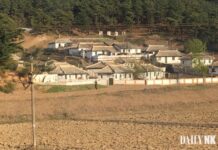Unification Media Group (UMG): In most modern nations, tending to a cold is a relatively straightforward matter. But in North Korea, where the healthcare sector struggles to cope with simple ailments, the situation is quite different. In fact, the ability to access care in North Korea’s “free universal medical system” is directly connected to the status of the patient’s profession and the size of the bribe they are able to pay. So when most residents get sick, they have no choice but to turn to the markets.
Today, we speak with special correspondent Kang Mi Jin to find out more about North Korea’s healthcare industry. The North Korean regime touts the country’s free, allegedly world-class healthcare for all citizens, but I wonder what things are really like on the ground.
Kang Mi Jin (Kang): According to inside sources, it’s true that the medical care system is free, but it’s so bad that most residents would rather not use it at all.
Unlike the rich and well-connected, the poor majority in North Korea have a hard time getting proper treatment. Ordinary residents are routinely pushed down surgery waiting lists to make way for the elite.
So most people prefer to use folk remedies and self medicate rather than seek treatment at a hospital. Today, we will get some first hand insights into how North Korean residents use medical devices.
UMG: We’ve learned that most medical devices being used by ordinary residents are decades old, whereas those used by the regime and Pyongyang’s inner circle are quite modern.
Kang: We’ve known for some time that the North Korean healthcare system is in tatters. From the mid 1990s, free medical care has virtually disappeared.
I recently spoke by phone with a North Korean resident who lives in Pyongsong City. They said that because the personal medical devices available in Pyongsong’s markets are expensive, people tend to go to Ryanggang Province, which has more internationally-oriented markets that sell medical devices wholesale at cheaper rates.
UMG: What kinds of devices are popular?
Blood pressure gauges, thermometers, and single-use syringes are the most commonly used items. Blood sugar monitors are popular, as are paper-based measurement devices.
But many people don’t like the blood sugar readers because they require the drawing of blood. Even though it’s only a small amount, it concerns them because most can hardly get enough nutrition in the first place. That’s why residents prefer the paper-based measurement devices, which only need urine and can be processed for free at a pharmacy if one has a medical certificate.
UMG: If the residents are really using these devices on their own, you’d expect that sales in the markets would be quite good. Can you tell us about the supply and demand for these medical devices, and why people choose to treat themselves rather than use the hospitals?
Kang: North Korea’s free healthcare system is not totally defunct; it still exists in certain ways. Residents are able to access the hospitals, but the quality of the care is directly connected to the socioeconomic status of the patient. Party cadres, the inner elite, and the rich have access to the country’s few good hospitals.
This type of discrimination occurs as a matter of routine at the smaller hospitals throughout the country. So people who do not have money tend to seek out medicine and devices in the markets so that they can treat themselves.
UMG: Can you tell us the costs for some of these devices?
Kang: In South Pyongan Province, disposable syringes sell for 700-1,000 KPW. Thermometers sell for 5,000 KPW. Chinese-made blood pressure gauges sell for 130,200 KPW, while North Korean versions sell for 65,000 KPW.
Sino-North Korean trade is resulting in an influx of relatively cheap medical devices. In Ryanggang Province’s Hyesan Market, blood pressure gauges sell for 120,500 KPW, and disposable syringes cost 500 KPW. This follows a general trend: products near the border tend to be less expensive than in the interior regions, due to the cost of transport and the prevalence of smuggling.
UMG: Is it normal for North Koreans to use syringes on themselves in their homes?
Kang: Yes, when people are busy, they often ask a neighbor or a family member to help them out rather than go to a hospital. Traveling to a hospital, checking in, and going through all the procedures is time-consuming. So it’s common to ask a relative to help administer first aid.
Most families have a small store of medicine at home. So for them it’s not a big deal to give themselves a shot or some medicine. From an outside point of view, or from a professional medical perspective, this probably seems like dangerous behavior, but it’s common practice in the North. For instance, some defectors that settle in the South will even tell their South Korean doctors what they think their diagnosis is.
Thank you for telling us about North Korea’s medical system. Now, we turn to this week’s market prices.
 All prices shown in KPW and current as of November 21, 2017. |
















